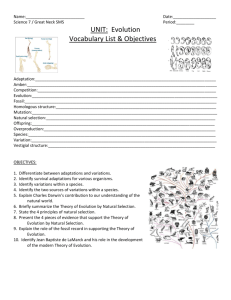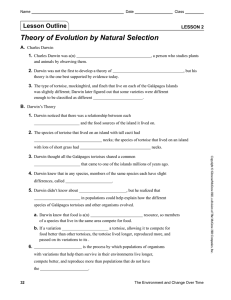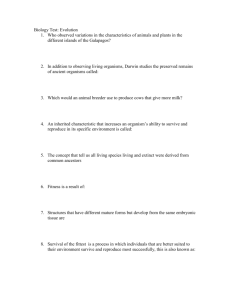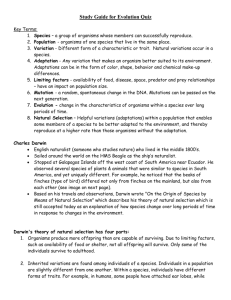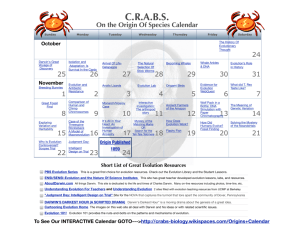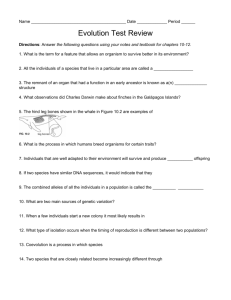6-2 evolution outline answers
advertisement
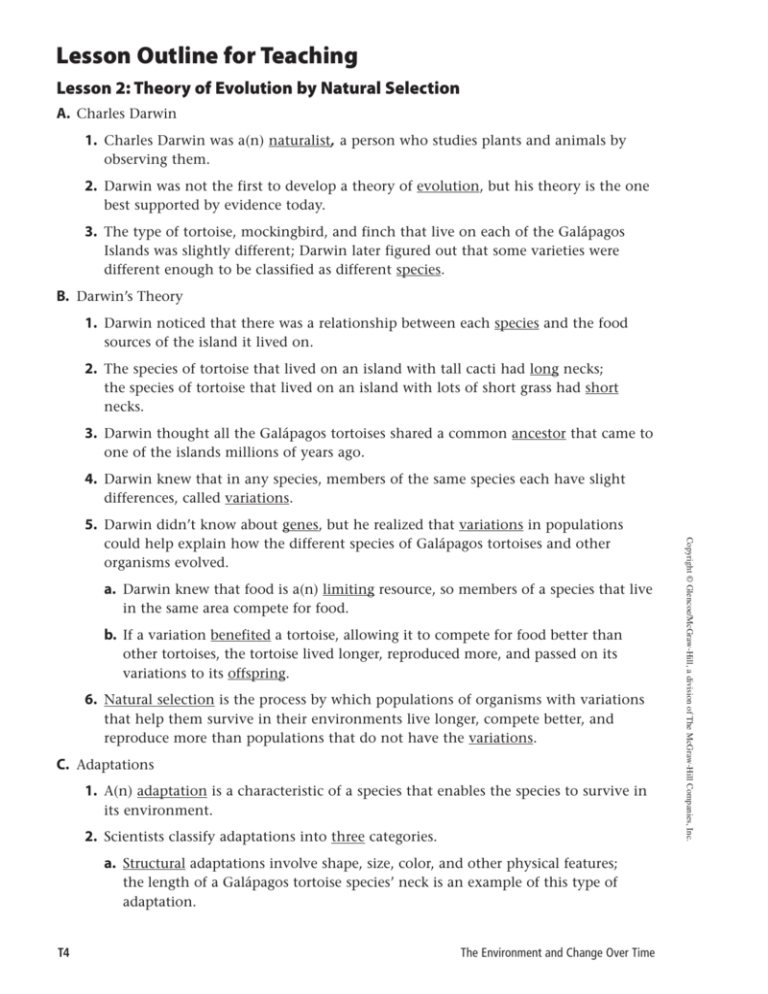
Lesson Outline for Teaching Lesson 2: Theory of Evolution by Natural Selection A. Charles Darwin 1. Charles Darwin was a(n) naturalist, a person who studies plants and animals by observing them. 2. Darwin was not the first to develop a theory of evolution, but his theory is the one best supported by evidence today. 3. The type of tortoise, mockingbird, and finch that live on each of the Galápagos Islands was slightly different; Darwin later figured out that some varieties were different enough to be classified as different species. B. Darwin’s Theory 1. Darwin noticed that there was a relationship between each species and the food sources of the island it lived on. 2. The species of tortoise that lived on an island with tall cacti had long necks; the species of tortoise that lived on an island with lots of short grass had short necks. 3. Darwin thought all the Galápagos tortoises shared a common ancestor that came to one of the islands millions of years ago. 4. Darwin knew that in any species, members of the same species each have slight differences, called variations. 5. Darwin didn’t know about genes, but he realized that variations in populations a. Darwin knew that food is a(n) limiting resource, so members of a species that live in the same area compete for food. b. If a variation benefited a tortoise, allowing it to compete for food better than other tortoises, the tortoise lived longer, reproduced more, and passed on its variations to its offspring. 6. Natural selection is the process by which populations of organisms with variations that help them survive in their environments live longer, compete better, and reproduce more than populations that do not have the variations. C. Adaptations 1. A(n) adaptation is a characteristic of a species that enables the species to survive in its environment. 2. Scientists classify adaptations into three categories. a. Structural adaptations involve shape, size, color, and other physical features; the length of a Galápagos tortoise species’ neck is an example of this type of adaptation. T4 The Environment and Change Over Time Copyright © Glencoe/McGraw-Hill, a division of The McGraw-Hill Companies, Inc. could help explain how the different species of Galápagos tortoises and other organisms evolved. Lesson Outline continued b. Behavioral adaptations involve the way organisms act; hunting at night is an example of this type of adaptation. c. Functional adaptations involve internal body systems that affect organisms’ biochemistry; expanding blood vessels that cool a jackrabbit’s blood is an example of this type of adaptation. 3. A structural adaptation that aids members of a species in blending in with their environment is called camouflage. 4. An adaptation in which one species resembles another species is called mimicry. 5. The living and the nonliving parts of the environment are always changing; species that cannot adapt to such changes will become extinct. D. Artificial Selection 1. Darwin’s theory of evolution by natural selection predicts that species will develop adaptations and, therefore, eventually closely match Earth’s changing environments. 2. Selective breeding is the breeding of organisms for desired characteristics. 3. Darwin realized that natural selection and selective breeding are similar processes. a. In natural selection, nature causes the changes in the species; in selective breeding, humans cause the changes in the species. Copyright © Glencoe/McGraw-Hill, a division of The McGraw-Hill Companies, Inc. b. For this reason, Darwin called selective breeding artificial selection. 4. Artificial selection explains and supports Darwin’s theory. Discussion Question Describe some adaptations that common animals you observe or know about have. Explain what might happen to each species if its environment changed in a significant way. Possible answers: a bird’s beak, which helps it get a particular food; a mammal’s or an insect’s coloration, which helps it hide in a particular environment; a mammal’s or bird’s claws, which help it capture a particular prey. After describing an adaptation, students should explain that a significant change in the environment could cause the species to become extinct unless offspring of that population developed variations leading to new adaptations that allowed them to survive and reproduce in the changed environment. If this happened, the species might evolve into a new species. The Environment and Change Over Time T5


